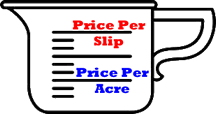 Appraisers, lenders and brokers have an unfortunate tendency to focus on price per slip as the unit of measure for marinas. Instead of simply getting cap rates from sales, too many appraisers do a full sales comparison approach and use nebulous, mere guesswork adjustments to derive a uniform price per slip range.
Appraisers, lenders and brokers have an unfortunate tendency to focus on price per slip as the unit of measure for marinas. Instead of simply getting cap rates from sales, too many appraisers do a full sales comparison approach and use nebulous, mere guesswork adjustments to derive a uniform price per slip range.
Here are the more germane reasons why price per slip doesn’t work for marinas:
- A marina can have many atypical components that make it subjective and impractical to adjust in this approach. Adjustments use price per slip as the common unit measure, yet how do we adjust for each component or group of components? There is simply no way to adjust any sale for the motel, catering building, downlands, large amounts of uplands or lack of repair facilities, either individually or collectively. Similarly, there is no way to adjust for the presence of a boat dealership or major repair facility in a comparable.
- Although the subject is a marina, it may be in a different submarket or market tier than its competitors for the many reasons above. Comparing properties in different market tiers is inherently subjective and there is no credible way to make an adjustment or adjustments. The typical market participant would view them differently and they would not compare them because he/she would recognize that they are not comparable.
- The number of slips present in a sale greatly affects the price per slip indicator. On a job we just finished, the range was from $7,421 to $80,000 per slip, which is an irreconcilably great range.
- How would the market react to the differences above? Price per slip might be considered in some superficial benchmark way, but market participants would not “adjust” as appraisers do. Instead, they would use an income approach. If the market does not do it or consider it, clearly appraisers should not either. If we did, the result would not be credible.
Another unit of measure that I have seen is price per square foot of land or price per acre. Even this measure can suffer from wild variations in land size and the presence or absence of wetlands. Sometimes the marine basin of a protected cove is owned in fee simple and that can also skew the results.
So what should the unit of measure be for a marina? Let the market be the guide!
- In some parts of the U.S., market participants think in terms of multiples, say buying a marina for 2, 2.5, 3 times gross or whatever. This thinking parallels the way many businesses are bought and marinas are businesses after all. It’s also easy to understand and the multiple can change up or down easily depending on a marina’s unique mix of business components (it parallels the perception of risk in the various businesses too).
- How about no unit of measure? If market participants don’t use a unit of measure, why should you? This is something we’ve seen trying to obtain cap rates for marinas via verification. It’s not uncommon to hear from owners, “what’s a cap rate?” , to hear them say they did not use price per slip as an indicator or that they did not base their purchase price on a multiple. Each time this happens, the market is telling you that there is no unit of measure.

